Developing a Digital Marketer Model for the Communication Industries
VerifiedAdded on 2023/04/25
|24
|10704
|148
Report
AI Summary
This report, based on research published in the International Journal of Information Management, investigates the digital marketing skills gap within the communication and creative industries. The study aims to identify the specific skills shortfalls and propose a model for digital marketers to address these deficiencies. The research employs interviews and focus groups to gather insights from industry professionals, focusing on their needs and challenges in the evolving digital landscape. The report reviews existing literature on the subject, emphasizing the need for industry-academia collaboration to bridge the skills gap. It highlights the importance of analytical, technical, and communication skills, as well as the ability to adapt to rapid technological changes and leverage data effectively. The findings underscore the need for continuous learning and development to keep pace with the dynamic nature of digital marketing and to ensure effective communication strategies. The report concludes with limitations of the approach and suggests areas for future research, contributing to both academic knowledge and practical application within the communication sector.
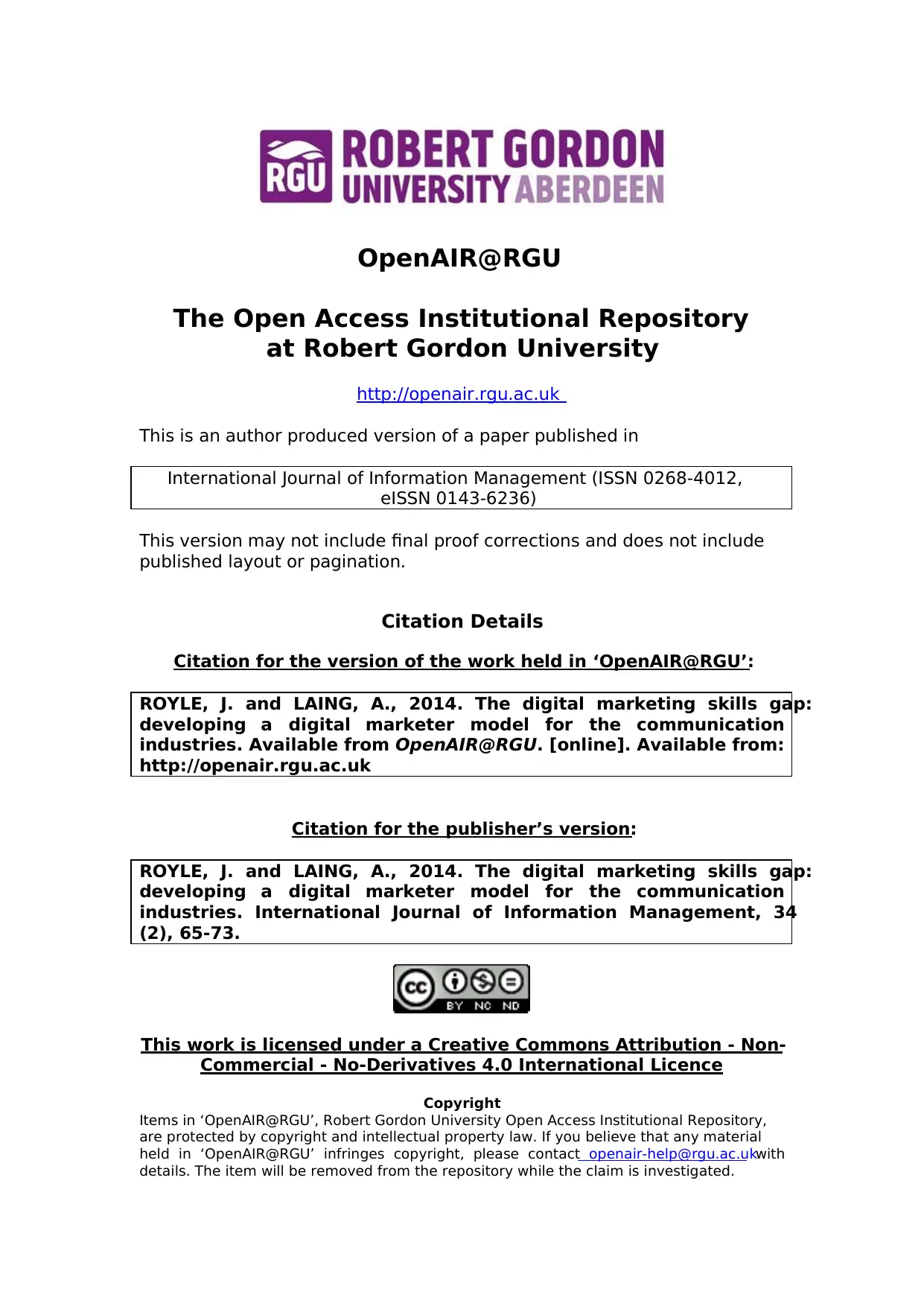
OpenAIR@RGU
The Open Access Institutional Repository
at Robert Gordon University
http://openair.rgu.ac.uk
This is an author produced version of a paper published in
International Journal of Information Management (ISSN 0268-4012,
eISSN 0143-6236)
This version may not include final proof corrections and does not include
published layout or pagination.
Citation Details
Citation for the version of the work held in ‘OpenAIR@RGU’:
ROYLE, J. and LAING, A., 2014. The digital marketing skills gap:
developing a digital marketer model for the communication
industries. Available from OpenAIR@RGU. [online]. Available from:
http://openair.rgu.ac.uk
Citation for the publisher’s version:
ROYLE, J. and LAING, A., 2014. The digital marketing skills gap:
developing a digital marketer model for the communication
industries. International Journal of Information Management, 34
(2), 65-73.
This work is licensed under a Creative Commons Attribution - Non-
Commercial - No-Derivatives 4.0 International Licence
Copyright
Items in ‘OpenAIR@RGU’, Robert Gordon University Open Access Institutional Repository,
are protected by copyright and intellectual property law. If you believe that any material
held in ‘OpenAIR@RGU’ infringes copyright, please contact openair-help@rgu.ac.ukwith
details. The item will be removed from the repository while the claim is investigated.
The Open Access Institutional Repository
at Robert Gordon University
http://openair.rgu.ac.uk
This is an author produced version of a paper published in
International Journal of Information Management (ISSN 0268-4012,
eISSN 0143-6236)
This version may not include final proof corrections and does not include
published layout or pagination.
Citation Details
Citation for the version of the work held in ‘OpenAIR@RGU’:
ROYLE, J. and LAING, A., 2014. The digital marketing skills gap:
developing a digital marketer model for the communication
industries. Available from OpenAIR@RGU. [online]. Available from:
http://openair.rgu.ac.uk
Citation for the publisher’s version:
ROYLE, J. and LAING, A., 2014. The digital marketing skills gap:
developing a digital marketer model for the communication
industries. International Journal of Information Management, 34
(2), 65-73.
This work is licensed under a Creative Commons Attribution - Non-
Commercial - No-Derivatives 4.0 International Licence
Copyright
Items in ‘OpenAIR@RGU’, Robert Gordon University Open Access Institutional Repository,
are protected by copyright and intellectual property law. If you believe that any material
held in ‘OpenAIR@RGU’ infringes copyright, please contact openair-help@rgu.ac.ukwith
details. The item will be removed from the repository while the claim is investigated.
Paraphrase This Document
Need a fresh take? Get an instant paraphrase of this document with our AI Paraphraser
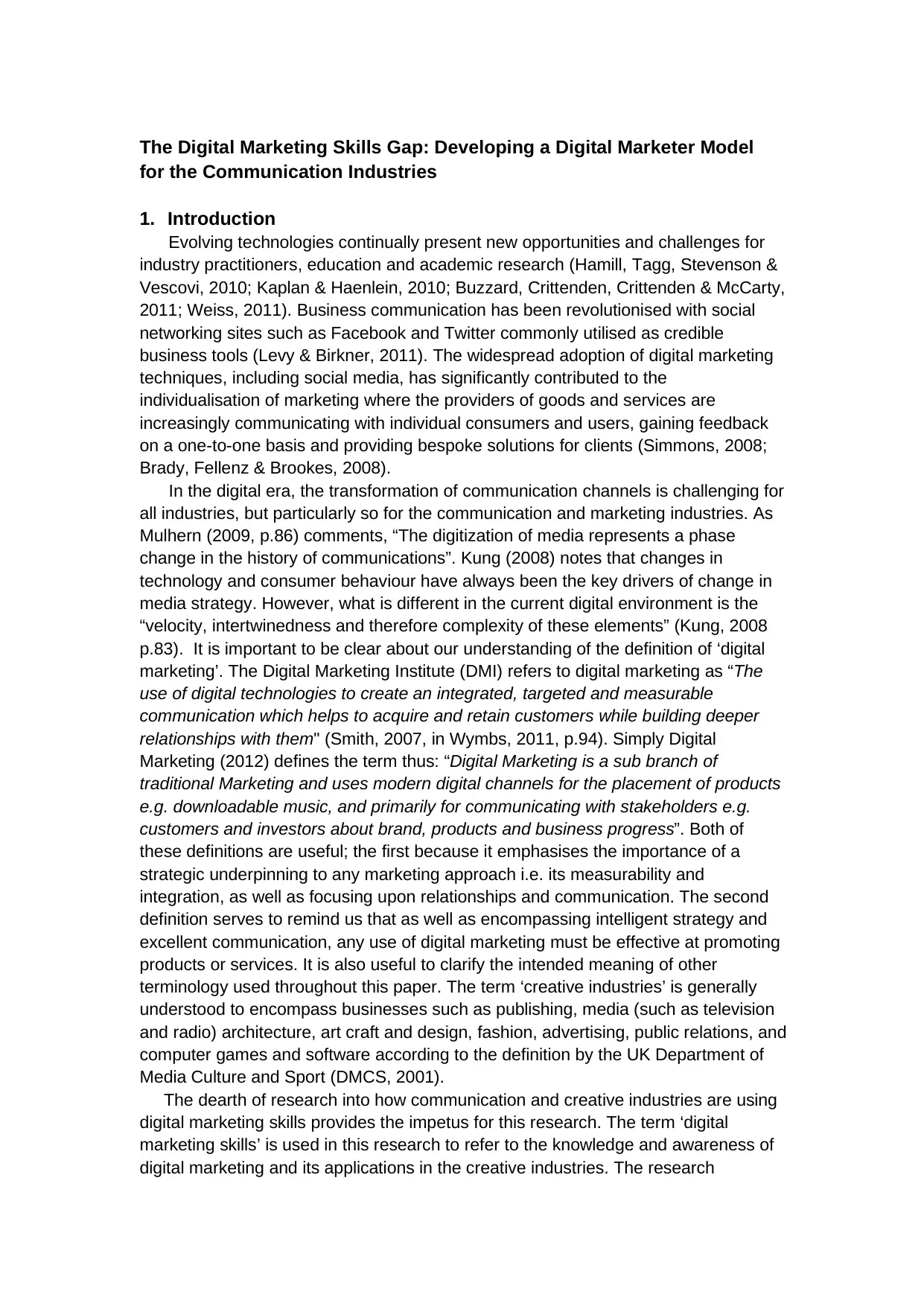
The Digital Marketing Skills Gap: Developing a Digital Marketer Model
for the Communication Industries
1. Introduction
Evolving technologies continually present new opportunities and challenges for
industry practitioners, education and academic research (Hamill, Tagg, Stevenson &
Vescovi, 2010; Kaplan & Haenlein, 2010; Buzzard, Crittenden, Crittenden & McCarty,
2011; Weiss, 2011). Business communication has been revolutionised with social
networking sites such as Facebook and Twitter commonly utilised as credible
business tools (Levy & Birkner, 2011). The widespread adoption of digital marketing
techniques, including social media, has significantly contributed to the
individualisation of marketing where the providers of goods and services are
increasingly communicating with individual consumers and users, gaining feedback
on a one-to-one basis and providing bespoke solutions for clients (Simmons, 2008;
Brady, Fellenz & Brookes, 2008).
In the digital era, the transformation of communication channels is challenging for
all industries, but particularly so for the communication and marketing industries. As
Mulhern (2009, p.86) comments, “The digitization of media represents a phase
change in the history of communications”. Kung (2008) notes that changes in
technology and consumer behaviour have always been the key drivers of change in
media strategy. However, what is different in the current digital environment is the
“velocity, intertwinedness and therefore complexity of these elements” (Kung, 2008
p.83). It is important to be clear about our understanding of the definition of ‘digital
marketing’. The Digital Marketing Institute (DMI) refers to digital marketing as “The
use of digital technologies to create an integrated, targeted and measurable
communication which helps to acquire and retain customers while building deeper
relationships with them" (Smith, 2007, in Wymbs, 2011, p.94). Simply Digital
Marketing (2012) defines the term thus: “Digital Marketing is a sub branch of
traditional Marketing and uses modern digital channels for the placement of products
e.g. downloadable music, and primarily for communicating with stakeholders e.g.
customers and investors about brand, products and business progress”. Both of
these definitions are useful; the first because it emphasises the importance of a
strategic underpinning to any marketing approach i.e. its measurability and
integration, as well as focusing upon relationships and communication. The second
definition serves to remind us that as well as encompassing intelligent strategy and
excellent communication, any use of digital marketing must be effective at promoting
products or services. It is also useful to clarify the intended meaning of other
terminology used throughout this paper. The term ‘creative industries’ is generally
understood to encompass businesses such as publishing, media (such as television
and radio) architecture, art craft and design, fashion, advertising, public relations, and
computer games and software according to the definition by the UK Department of
Media Culture and Sport (DMCS, 2001).
The dearth of research into how communication and creative industries are using
digital marketing skills provides the impetus for this research. The term ‘digital
marketing skills’ is used in this research to refer to the knowledge and awareness of
digital marketing and its applications in the creative industries. The research
for the Communication Industries
1. Introduction
Evolving technologies continually present new opportunities and challenges for
industry practitioners, education and academic research (Hamill, Tagg, Stevenson &
Vescovi, 2010; Kaplan & Haenlein, 2010; Buzzard, Crittenden, Crittenden & McCarty,
2011; Weiss, 2011). Business communication has been revolutionised with social
networking sites such as Facebook and Twitter commonly utilised as credible
business tools (Levy & Birkner, 2011). The widespread adoption of digital marketing
techniques, including social media, has significantly contributed to the
individualisation of marketing where the providers of goods and services are
increasingly communicating with individual consumers and users, gaining feedback
on a one-to-one basis and providing bespoke solutions for clients (Simmons, 2008;
Brady, Fellenz & Brookes, 2008).
In the digital era, the transformation of communication channels is challenging for
all industries, but particularly so for the communication and marketing industries. As
Mulhern (2009, p.86) comments, “The digitization of media represents a phase
change in the history of communications”. Kung (2008) notes that changes in
technology and consumer behaviour have always been the key drivers of change in
media strategy. However, what is different in the current digital environment is the
“velocity, intertwinedness and therefore complexity of these elements” (Kung, 2008
p.83). It is important to be clear about our understanding of the definition of ‘digital
marketing’. The Digital Marketing Institute (DMI) refers to digital marketing as “The
use of digital technologies to create an integrated, targeted and measurable
communication which helps to acquire and retain customers while building deeper
relationships with them" (Smith, 2007, in Wymbs, 2011, p.94). Simply Digital
Marketing (2012) defines the term thus: “Digital Marketing is a sub branch of
traditional Marketing and uses modern digital channels for the placement of products
e.g. downloadable music, and primarily for communicating with stakeholders e.g.
customers and investors about brand, products and business progress”. Both of
these definitions are useful; the first because it emphasises the importance of a
strategic underpinning to any marketing approach i.e. its measurability and
integration, as well as focusing upon relationships and communication. The second
definition serves to remind us that as well as encompassing intelligent strategy and
excellent communication, any use of digital marketing must be effective at promoting
products or services. It is also useful to clarify the intended meaning of other
terminology used throughout this paper. The term ‘creative industries’ is generally
understood to encompass businesses such as publishing, media (such as television
and radio) architecture, art craft and design, fashion, advertising, public relations, and
computer games and software according to the definition by the UK Department of
Media Culture and Sport (DMCS, 2001).
The dearth of research into how communication and creative industries are using
digital marketing skills provides the impetus for this research. The term ‘digital
marketing skills’ is used in this research to refer to the knowledge and awareness of
digital marketing and its applications in the creative industries. The research
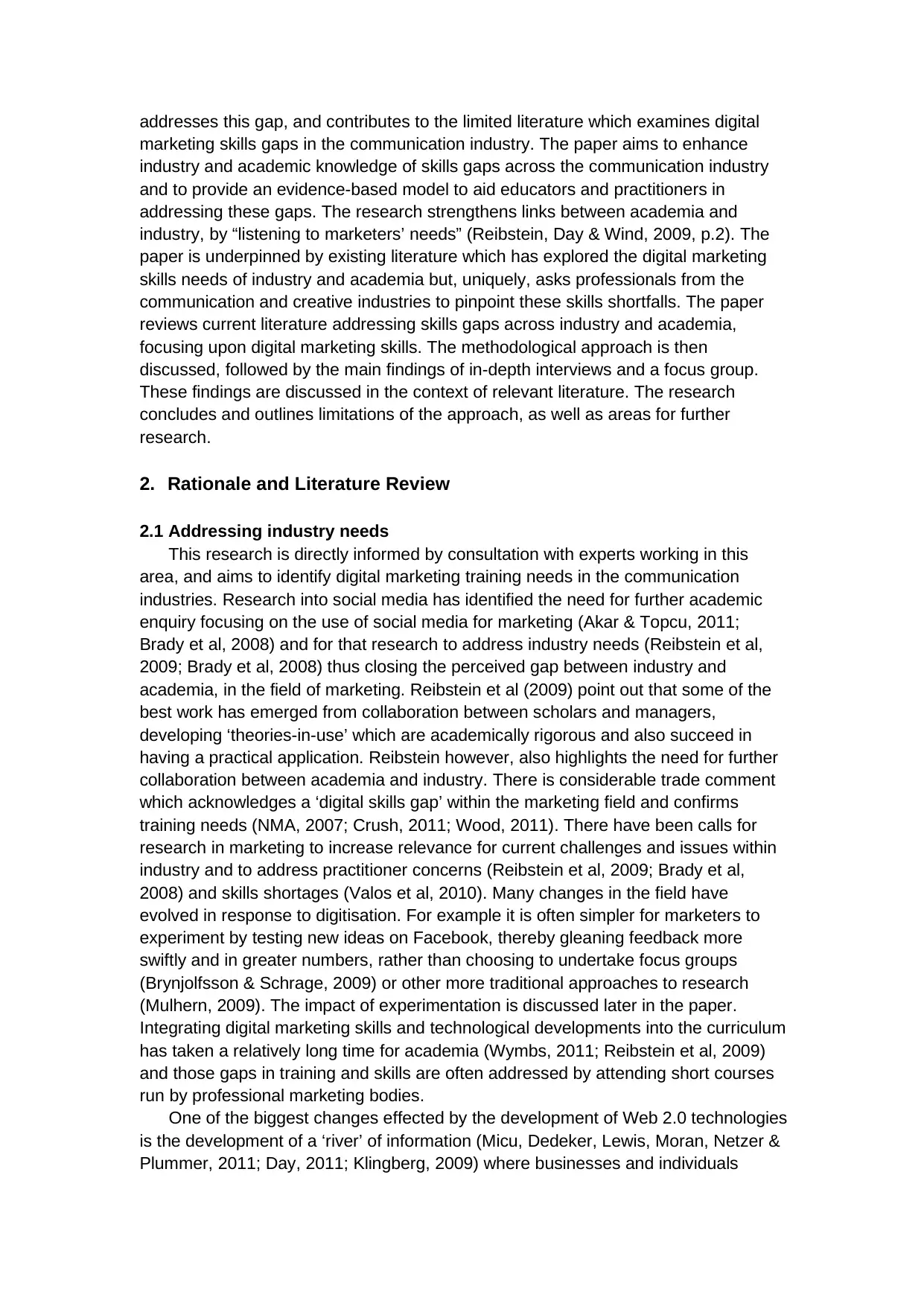
addresses this gap, and contributes to the limited literature which examines digital
marketing skills gaps in the communication industry. The paper aims to enhance
industry and academic knowledge of skills gaps across the communication industry
and to provide an evidence-based model to aid educators and practitioners in
addressing these gaps. The research strengthens links between academia and
industry, by “listening to marketers’ needs” (Reibstein, Day & Wind, 2009, p.2). The
paper is underpinned by existing literature which has explored the digital marketing
skills needs of industry and academia but, uniquely, asks professionals from the
communication and creative industries to pinpoint these skills shortfalls. The paper
reviews current literature addressing skills gaps across industry and academia,
focusing upon digital marketing skills. The methodological approach is then
discussed, followed by the main findings of in-depth interviews and a focus group.
These findings are discussed in the context of relevant literature. The research
concludes and outlines limitations of the approach, as well as areas for further
research.
2. Rationale and Literature Review
2.1 Addressing industry needs
This research is directly informed by consultation with experts working in this
area, and aims to identify digital marketing training needs in the communication
industries. Research into social media has identified the need for further academic
enquiry focusing on the use of social media for marketing (Akar & Topcu, 2011;
Brady et al, 2008) and for that research to address industry needs (Reibstein et al,
2009; Brady et al, 2008) thus closing the perceived gap between industry and
academia, in the field of marketing. Reibstein et al (2009) point out that some of the
best work has emerged from collaboration between scholars and managers,
developing ‘theories-in-use’ which are academically rigorous and also succeed in
having a practical application. Reibstein however, also highlights the need for further
collaboration between academia and industry. There is considerable trade comment
which acknowledges a ‘digital skills gap’ within the marketing field and confirms
training needs (NMA, 2007; Crush, 2011; Wood, 2011). There have been calls for
research in marketing to increase relevance for current challenges and issues within
industry and to address practitioner concerns (Reibstein et al, 2009; Brady et al,
2008) and skills shortages (Valos et al, 2010). Many changes in the field have
evolved in response to digitisation. For example it is often simpler for marketers to
experiment by testing new ideas on Facebook, thereby gleaning feedback more
swiftly and in greater numbers, rather than choosing to undertake focus groups
(Brynjolfsson & Schrage, 2009) or other more traditional approaches to research
(Mulhern, 2009). The impact of experimentation is discussed later in the paper.
Integrating digital marketing skills and technological developments into the curriculum
has taken a relatively long time for academia (Wymbs, 2011; Reibstein et al, 2009)
and those gaps in training and skills are often addressed by attending short courses
run by professional marketing bodies.
One of the biggest changes effected by the development of Web 2.0 technologies
is the development of a ‘river’ of information (Micu, Dedeker, Lewis, Moran, Netzer &
Plummer, 2011; Day, 2011; Klingberg, 2009) where businesses and individuals
marketing skills gaps in the communication industry. The paper aims to enhance
industry and academic knowledge of skills gaps across the communication industry
and to provide an evidence-based model to aid educators and practitioners in
addressing these gaps. The research strengthens links between academia and
industry, by “listening to marketers’ needs” (Reibstein, Day & Wind, 2009, p.2). The
paper is underpinned by existing literature which has explored the digital marketing
skills needs of industry and academia but, uniquely, asks professionals from the
communication and creative industries to pinpoint these skills shortfalls. The paper
reviews current literature addressing skills gaps across industry and academia,
focusing upon digital marketing skills. The methodological approach is then
discussed, followed by the main findings of in-depth interviews and a focus group.
These findings are discussed in the context of relevant literature. The research
concludes and outlines limitations of the approach, as well as areas for further
research.
2. Rationale and Literature Review
2.1 Addressing industry needs
This research is directly informed by consultation with experts working in this
area, and aims to identify digital marketing training needs in the communication
industries. Research into social media has identified the need for further academic
enquiry focusing on the use of social media for marketing (Akar & Topcu, 2011;
Brady et al, 2008) and for that research to address industry needs (Reibstein et al,
2009; Brady et al, 2008) thus closing the perceived gap between industry and
academia, in the field of marketing. Reibstein et al (2009) point out that some of the
best work has emerged from collaboration between scholars and managers,
developing ‘theories-in-use’ which are academically rigorous and also succeed in
having a practical application. Reibstein however, also highlights the need for further
collaboration between academia and industry. There is considerable trade comment
which acknowledges a ‘digital skills gap’ within the marketing field and confirms
training needs (NMA, 2007; Crush, 2011; Wood, 2011). There have been calls for
research in marketing to increase relevance for current challenges and issues within
industry and to address practitioner concerns (Reibstein et al, 2009; Brady et al,
2008) and skills shortages (Valos et al, 2010). Many changes in the field have
evolved in response to digitisation. For example it is often simpler for marketers to
experiment by testing new ideas on Facebook, thereby gleaning feedback more
swiftly and in greater numbers, rather than choosing to undertake focus groups
(Brynjolfsson & Schrage, 2009) or other more traditional approaches to research
(Mulhern, 2009). The impact of experimentation is discussed later in the paper.
Integrating digital marketing skills and technological developments into the curriculum
has taken a relatively long time for academia (Wymbs, 2011; Reibstein et al, 2009)
and those gaps in training and skills are often addressed by attending short courses
run by professional marketing bodies.
One of the biggest changes effected by the development of Web 2.0 technologies
is the development of a ‘river’ of information (Micu, Dedeker, Lewis, Moran, Netzer &
Plummer, 2011; Day, 2011; Klingberg, 2009) where businesses and individuals
⊘ This is a preview!⊘
Do you want full access?
Subscribe today to unlock all pages.

Trusted by 1+ million students worldwide
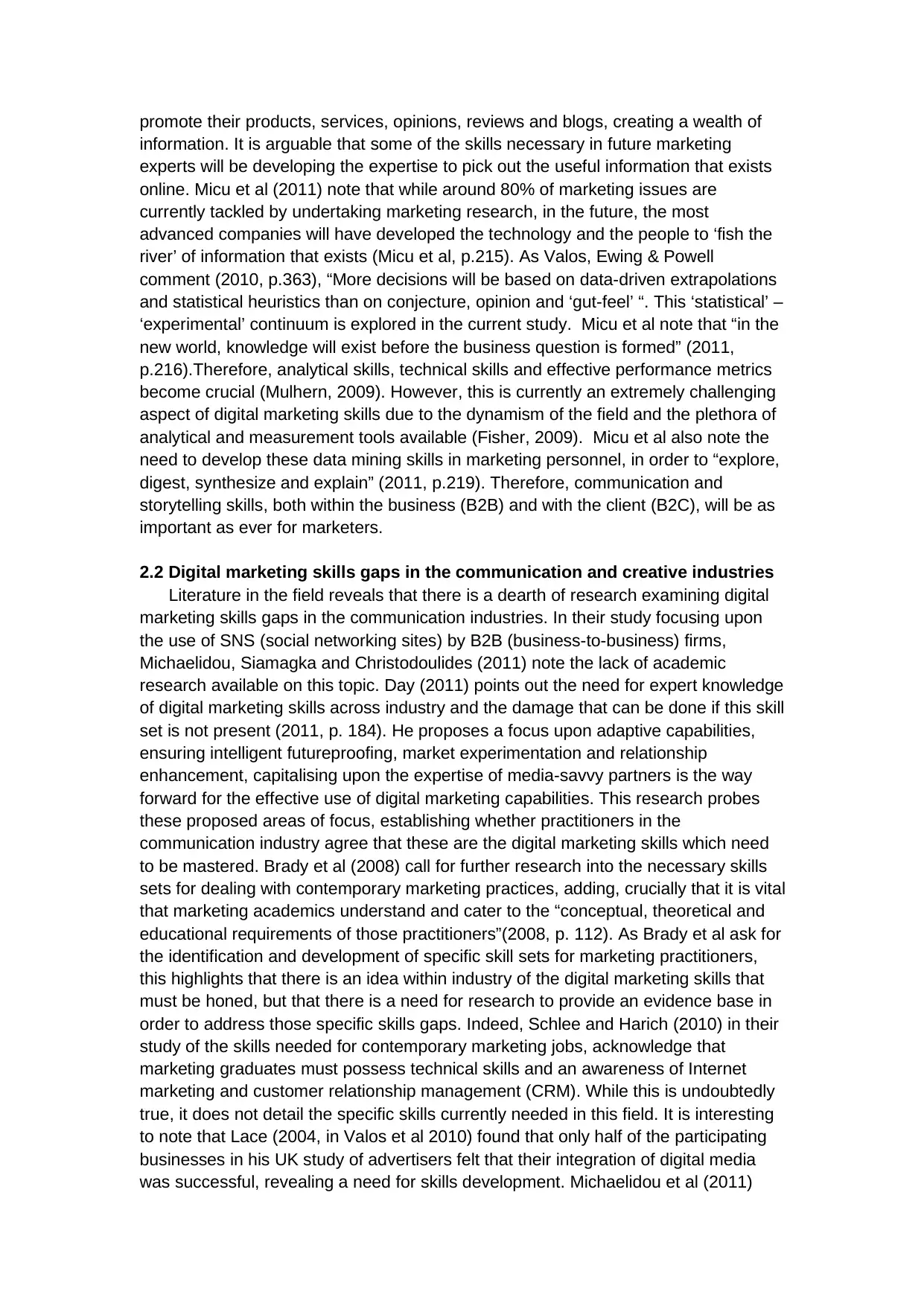
promote their products, services, opinions, reviews and blogs, creating a wealth of
information. It is arguable that some of the skills necessary in future marketing
experts will be developing the expertise to pick out the useful information that exists
online. Micu et al (2011) note that while around 80% of marketing issues are
currently tackled by undertaking marketing research, in the future, the most
advanced companies will have developed the technology and the people to ‘fish the
river’ of information that exists (Micu et al, p.215). As Valos, Ewing & Powell
comment (2010, p.363), “More decisions will be based on data-driven extrapolations
and statistical heuristics than on conjecture, opinion and ‘gut-feel’ “. This ‘statistical’ –
‘experimental’ continuum is explored in the current study. Micu et al note that “in the
new world, knowledge will exist before the business question is formed” (2011,
p.216).Therefore, analytical skills, technical skills and effective performance metrics
become crucial (Mulhern, 2009). However, this is currently an extremely challenging
aspect of digital marketing skills due to the dynamism of the field and the plethora of
analytical and measurement tools available (Fisher, 2009). Micu et al also note the
need to develop these data mining skills in marketing personnel, in order to “explore,
digest, synthesize and explain” (2011, p.219). Therefore, communication and
storytelling skills, both within the business (B2B) and with the client (B2C), will be as
important as ever for marketers.
2.2 Digital marketing skills gaps in the communication and creative industries
Literature in the field reveals that there is a dearth of research examining digital
marketing skills gaps in the communication industries. In their study focusing upon
the use of SNS (social networking sites) by B2B (business-to-business) firms,
Michaelidou, Siamagka and Christodoulides (2011) note the lack of academic
research available on this topic. Day (2011) points out the need for expert knowledge
of digital marketing skills across industry and the damage that can be done if this skill
set is not present (2011, p. 184). He proposes a focus upon adaptive capabilities,
ensuring intelligent futureproofing, market experimentation and relationship
enhancement, capitalising upon the expertise of media-savvy partners is the way
forward for the effective use of digital marketing capabilities. This research probes
these proposed areas of focus, establishing whether practitioners in the
communication industry agree that these are the digital marketing skills which need
to be mastered. Brady et al (2008) call for further research into the necessary skills
sets for dealing with contemporary marketing practices, adding, crucially that it is vital
that marketing academics understand and cater to the “conceptual, theoretical and
educational requirements of those practitioners”(2008, p. 112). As Brady et al ask for
the identification and development of specific skill sets for marketing practitioners,
this highlights that there is an idea within industry of the digital marketing skills that
must be honed, but that there is a need for research to provide an evidence base in
order to address those specific skills gaps. Indeed, Schlee and Harich (2010) in their
study of the skills needed for contemporary marketing jobs, acknowledge that
marketing graduates must possess technical skills and an awareness of Internet
marketing and customer relationship management (CRM). While this is undoubtedly
true, it does not detail the specific skills currently needed in this field. It is interesting
to note that Lace (2004, in Valos et al 2010) found that only half of the participating
businesses in his UK study of advertisers felt that their integration of digital media
was successful, revealing a need for skills development. Michaelidou et al (2011)
information. It is arguable that some of the skills necessary in future marketing
experts will be developing the expertise to pick out the useful information that exists
online. Micu et al (2011) note that while around 80% of marketing issues are
currently tackled by undertaking marketing research, in the future, the most
advanced companies will have developed the technology and the people to ‘fish the
river’ of information that exists (Micu et al, p.215). As Valos, Ewing & Powell
comment (2010, p.363), “More decisions will be based on data-driven extrapolations
and statistical heuristics than on conjecture, opinion and ‘gut-feel’ “. This ‘statistical’ –
‘experimental’ continuum is explored in the current study. Micu et al note that “in the
new world, knowledge will exist before the business question is formed” (2011,
p.216).Therefore, analytical skills, technical skills and effective performance metrics
become crucial (Mulhern, 2009). However, this is currently an extremely challenging
aspect of digital marketing skills due to the dynamism of the field and the plethora of
analytical and measurement tools available (Fisher, 2009). Micu et al also note the
need to develop these data mining skills in marketing personnel, in order to “explore,
digest, synthesize and explain” (2011, p.219). Therefore, communication and
storytelling skills, both within the business (B2B) and with the client (B2C), will be as
important as ever for marketers.
2.2 Digital marketing skills gaps in the communication and creative industries
Literature in the field reveals that there is a dearth of research examining digital
marketing skills gaps in the communication industries. In their study focusing upon
the use of SNS (social networking sites) by B2B (business-to-business) firms,
Michaelidou, Siamagka and Christodoulides (2011) note the lack of academic
research available on this topic. Day (2011) points out the need for expert knowledge
of digital marketing skills across industry and the damage that can be done if this skill
set is not present (2011, p. 184). He proposes a focus upon adaptive capabilities,
ensuring intelligent futureproofing, market experimentation and relationship
enhancement, capitalising upon the expertise of media-savvy partners is the way
forward for the effective use of digital marketing capabilities. This research probes
these proposed areas of focus, establishing whether practitioners in the
communication industry agree that these are the digital marketing skills which need
to be mastered. Brady et al (2008) call for further research into the necessary skills
sets for dealing with contemporary marketing practices, adding, crucially that it is vital
that marketing academics understand and cater to the “conceptual, theoretical and
educational requirements of those practitioners”(2008, p. 112). As Brady et al ask for
the identification and development of specific skill sets for marketing practitioners,
this highlights that there is an idea within industry of the digital marketing skills that
must be honed, but that there is a need for research to provide an evidence base in
order to address those specific skills gaps. Indeed, Schlee and Harich (2010) in their
study of the skills needed for contemporary marketing jobs, acknowledge that
marketing graduates must possess technical skills and an awareness of Internet
marketing and customer relationship management (CRM). While this is undoubtedly
true, it does not detail the specific skills currently needed in this field. It is interesting
to note that Lace (2004, in Valos et al 2010) found that only half of the participating
businesses in his UK study of advertisers felt that their integration of digital media
was successful, revealing a need for skills development. Michaelidou et al (2011)
Paraphrase This Document
Need a fresh take? Get an instant paraphrase of this document with our AI Paraphraser
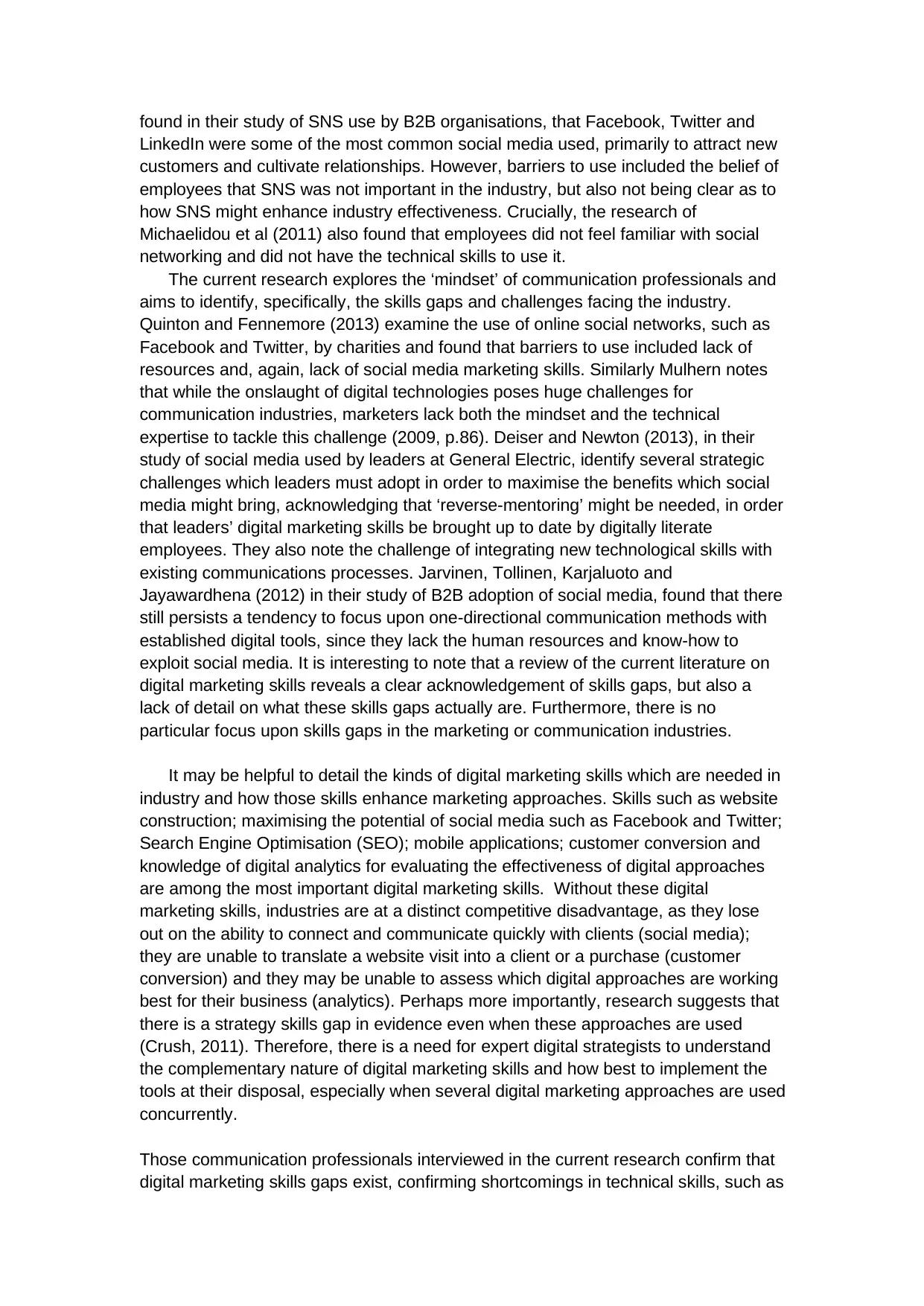
found in their study of SNS use by B2B organisations, that Facebook, Twitter and
LinkedIn were some of the most common social media used, primarily to attract new
customers and cultivate relationships. However, barriers to use included the belief of
employees that SNS was not important in the industry, but also not being clear as to
how SNS might enhance industry effectiveness. Crucially, the research of
Michaelidou et al (2011) also found that employees did not feel familiar with social
networking and did not have the technical skills to use it.
The current research explores the ‘mindset’ of communication professionals and
aims to identify, specifically, the skills gaps and challenges facing the industry.
Quinton and Fennemore (2013) examine the use of online social networks, such as
Facebook and Twitter, by charities and found that barriers to use included lack of
resources and, again, lack of social media marketing skills. Similarly Mulhern notes
that while the onslaught of digital technologies poses huge challenges for
communication industries, marketers lack both the mindset and the technical
expertise to tackle this challenge (2009, p.86). Deiser and Newton (2013), in their
study of social media used by leaders at General Electric, identify several strategic
challenges which leaders must adopt in order to maximise the benefits which social
media might bring, acknowledging that ‘reverse-mentoring’ might be needed, in order
that leaders’ digital marketing skills be brought up to date by digitally literate
employees. They also note the challenge of integrating new technological skills with
existing communications processes. Jarvinen, Tollinen, Karjaluoto and
Jayawardhena (2012) in their study of B2B adoption of social media, found that there
still persists a tendency to focus upon one-directional communication methods with
established digital tools, since they lack the human resources and know-how to
exploit social media. It is interesting to note that a review of the current literature on
digital marketing skills reveals a clear acknowledgement of skills gaps, but also a
lack of detail on what these skills gaps actually are. Furthermore, there is no
particular focus upon skills gaps in the marketing or communication industries.
It may be helpful to detail the kinds of digital marketing skills which are needed in
industry and how those skills enhance marketing approaches. Skills such as website
construction; maximising the potential of social media such as Facebook and Twitter;
Search Engine Optimisation (SEO); mobile applications; customer conversion and
knowledge of digital analytics for evaluating the effectiveness of digital approaches
are among the most important digital marketing skills. Without these digital
marketing skills, industries are at a distinct competitive disadvantage, as they lose
out on the ability to connect and communicate quickly with clients (social media);
they are unable to translate a website visit into a client or a purchase (customer
conversion) and they may be unable to assess which digital approaches are working
best for their business (analytics). Perhaps more importantly, research suggests that
there is a strategy skills gap in evidence even when these approaches are used
(Crush, 2011). Therefore, there is a need for expert digital strategists to understand
the complementary nature of digital marketing skills and how best to implement the
tools at their disposal, especially when several digital marketing approaches are used
concurrently.
Those communication professionals interviewed in the current research confirm that
digital marketing skills gaps exist, confirming shortcomings in technical skills, such as
LinkedIn were some of the most common social media used, primarily to attract new
customers and cultivate relationships. However, barriers to use included the belief of
employees that SNS was not important in the industry, but also not being clear as to
how SNS might enhance industry effectiveness. Crucially, the research of
Michaelidou et al (2011) also found that employees did not feel familiar with social
networking and did not have the technical skills to use it.
The current research explores the ‘mindset’ of communication professionals and
aims to identify, specifically, the skills gaps and challenges facing the industry.
Quinton and Fennemore (2013) examine the use of online social networks, such as
Facebook and Twitter, by charities and found that barriers to use included lack of
resources and, again, lack of social media marketing skills. Similarly Mulhern notes
that while the onslaught of digital technologies poses huge challenges for
communication industries, marketers lack both the mindset and the technical
expertise to tackle this challenge (2009, p.86). Deiser and Newton (2013), in their
study of social media used by leaders at General Electric, identify several strategic
challenges which leaders must adopt in order to maximise the benefits which social
media might bring, acknowledging that ‘reverse-mentoring’ might be needed, in order
that leaders’ digital marketing skills be brought up to date by digitally literate
employees. They also note the challenge of integrating new technological skills with
existing communications processes. Jarvinen, Tollinen, Karjaluoto and
Jayawardhena (2012) in their study of B2B adoption of social media, found that there
still persists a tendency to focus upon one-directional communication methods with
established digital tools, since they lack the human resources and know-how to
exploit social media. It is interesting to note that a review of the current literature on
digital marketing skills reveals a clear acknowledgement of skills gaps, but also a
lack of detail on what these skills gaps actually are. Furthermore, there is no
particular focus upon skills gaps in the marketing or communication industries.
It may be helpful to detail the kinds of digital marketing skills which are needed in
industry and how those skills enhance marketing approaches. Skills such as website
construction; maximising the potential of social media such as Facebook and Twitter;
Search Engine Optimisation (SEO); mobile applications; customer conversion and
knowledge of digital analytics for evaluating the effectiveness of digital approaches
are among the most important digital marketing skills. Without these digital
marketing skills, industries are at a distinct competitive disadvantage, as they lose
out on the ability to connect and communicate quickly with clients (social media);
they are unable to translate a website visit into a client or a purchase (customer
conversion) and they may be unable to assess which digital approaches are working
best for their business (analytics). Perhaps more importantly, research suggests that
there is a strategy skills gap in evidence even when these approaches are used
(Crush, 2011). Therefore, there is a need for expert digital strategists to understand
the complementary nature of digital marketing skills and how best to implement the
tools at their disposal, especially when several digital marketing approaches are used
concurrently.
Those communication professionals interviewed in the current research confirm that
digital marketing skills gaps exist, confirming shortcomings in technical skills, such as
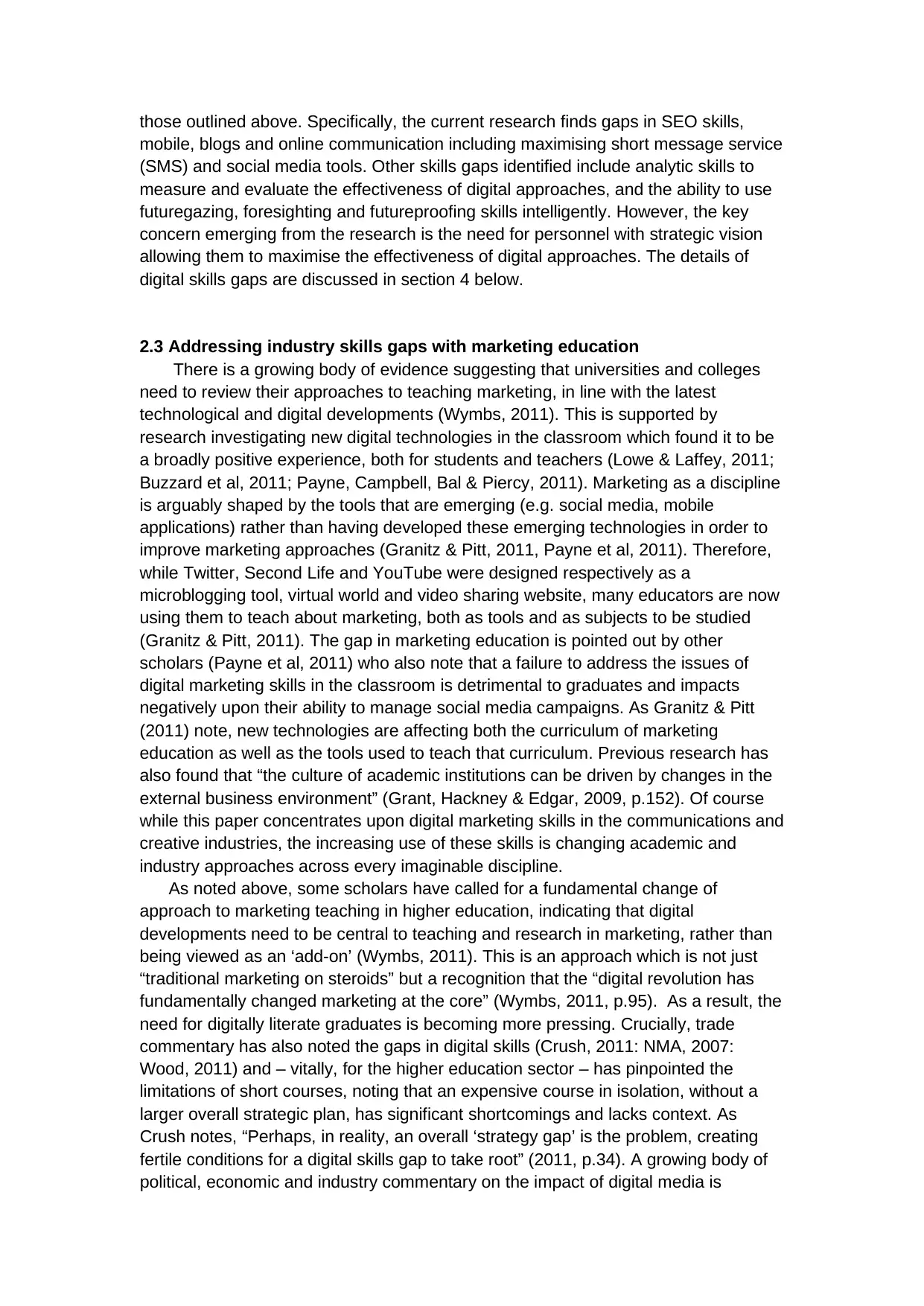
those outlined above. Specifically, the current research finds gaps in SEO skills,
mobile, blogs and online communication including maximising short message service
(SMS) and social media tools. Other skills gaps identified include analytic skills to
measure and evaluate the effectiveness of digital approaches, and the ability to use
futuregazing, foresighting and futureproofing skills intelligently. However, the key
concern emerging from the research is the need for personnel with strategic vision
allowing them to maximise the effectiveness of digital approaches. The details of
digital skills gaps are discussed in section 4 below.
2.3 Addressing industry skills gaps with marketing education
There is a growing body of evidence suggesting that universities and colleges
need to review their approaches to teaching marketing, in line with the latest
technological and digital developments (Wymbs, 2011). This is supported by
research investigating new digital technologies in the classroom which found it to be
a broadly positive experience, both for students and teachers (Lowe & Laffey, 2011;
Buzzard et al, 2011; Payne, Campbell, Bal & Piercy, 2011). Marketing as a discipline
is arguably shaped by the tools that are emerging (e.g. social media, mobile
applications) rather than having developed these emerging technologies in order to
improve marketing approaches (Granitz & Pitt, 2011, Payne et al, 2011). Therefore,
while Twitter, Second Life and YouTube were designed respectively as a
microblogging tool, virtual world and video sharing website, many educators are now
using them to teach about marketing, both as tools and as subjects to be studied
(Granitz & Pitt, 2011). The gap in marketing education is pointed out by other
scholars (Payne et al, 2011) who also note that a failure to address the issues of
digital marketing skills in the classroom is detrimental to graduates and impacts
negatively upon their ability to manage social media campaigns. As Granitz & Pitt
(2011) note, new technologies are affecting both the curriculum of marketing
education as well as the tools used to teach that curriculum. Previous research has
also found that “the culture of academic institutions can be driven by changes in the
external business environment” (Grant, Hackney & Edgar, 2009, p.152). Of course
while this paper concentrates upon digital marketing skills in the communications and
creative industries, the increasing use of these skills is changing academic and
industry approaches across every imaginable discipline.
As noted above, some scholars have called for a fundamental change of
approach to marketing teaching in higher education, indicating that digital
developments need to be central to teaching and research in marketing, rather than
being viewed as an ‘add-on’ (Wymbs, 2011). This is an approach which is not just
“traditional marketing on steroids” but a recognition that the “digital revolution has
fundamentally changed marketing at the core” (Wymbs, 2011, p.95). As a result, the
need for digitally literate graduates is becoming more pressing. Crucially, trade
commentary has also noted the gaps in digital skills (Crush, 2011: NMA, 2007:
Wood, 2011) and – vitally, for the higher education sector – has pinpointed the
limitations of short courses, noting that an expensive course in isolation, without a
larger overall strategic plan, has significant shortcomings and lacks context. As
Crush notes, “Perhaps, in reality, an overall ‘strategy gap’ is the problem, creating
fertile conditions for a digital skills gap to take root” (2011, p.34). A growing body of
political, economic and industry commentary on the impact of digital media is
mobile, blogs and online communication including maximising short message service
(SMS) and social media tools. Other skills gaps identified include analytic skills to
measure and evaluate the effectiveness of digital approaches, and the ability to use
futuregazing, foresighting and futureproofing skills intelligently. However, the key
concern emerging from the research is the need for personnel with strategic vision
allowing them to maximise the effectiveness of digital approaches. The details of
digital skills gaps are discussed in section 4 below.
2.3 Addressing industry skills gaps with marketing education
There is a growing body of evidence suggesting that universities and colleges
need to review their approaches to teaching marketing, in line with the latest
technological and digital developments (Wymbs, 2011). This is supported by
research investigating new digital technologies in the classroom which found it to be
a broadly positive experience, both for students and teachers (Lowe & Laffey, 2011;
Buzzard et al, 2011; Payne, Campbell, Bal & Piercy, 2011). Marketing as a discipline
is arguably shaped by the tools that are emerging (e.g. social media, mobile
applications) rather than having developed these emerging technologies in order to
improve marketing approaches (Granitz & Pitt, 2011, Payne et al, 2011). Therefore,
while Twitter, Second Life and YouTube were designed respectively as a
microblogging tool, virtual world and video sharing website, many educators are now
using them to teach about marketing, both as tools and as subjects to be studied
(Granitz & Pitt, 2011). The gap in marketing education is pointed out by other
scholars (Payne et al, 2011) who also note that a failure to address the issues of
digital marketing skills in the classroom is detrimental to graduates and impacts
negatively upon their ability to manage social media campaigns. As Granitz & Pitt
(2011) note, new technologies are affecting both the curriculum of marketing
education as well as the tools used to teach that curriculum. Previous research has
also found that “the culture of academic institutions can be driven by changes in the
external business environment” (Grant, Hackney & Edgar, 2009, p.152). Of course
while this paper concentrates upon digital marketing skills in the communications and
creative industries, the increasing use of these skills is changing academic and
industry approaches across every imaginable discipline.
As noted above, some scholars have called for a fundamental change of
approach to marketing teaching in higher education, indicating that digital
developments need to be central to teaching and research in marketing, rather than
being viewed as an ‘add-on’ (Wymbs, 2011). This is an approach which is not just
“traditional marketing on steroids” but a recognition that the “digital revolution has
fundamentally changed marketing at the core” (Wymbs, 2011, p.95). As a result, the
need for digitally literate graduates is becoming more pressing. Crucially, trade
commentary has also noted the gaps in digital skills (Crush, 2011: NMA, 2007:
Wood, 2011) and – vitally, for the higher education sector – has pinpointed the
limitations of short courses, noting that an expensive course in isolation, without a
larger overall strategic plan, has significant shortcomings and lacks context. As
Crush notes, “Perhaps, in reality, an overall ‘strategy gap’ is the problem, creating
fertile conditions for a digital skills gap to take root” (2011, p.34). A growing body of
political, economic and industry commentary on the impact of digital media is
⊘ This is a preview!⊘
Do you want full access?
Subscribe today to unlock all pages.

Trusted by 1+ million students worldwide
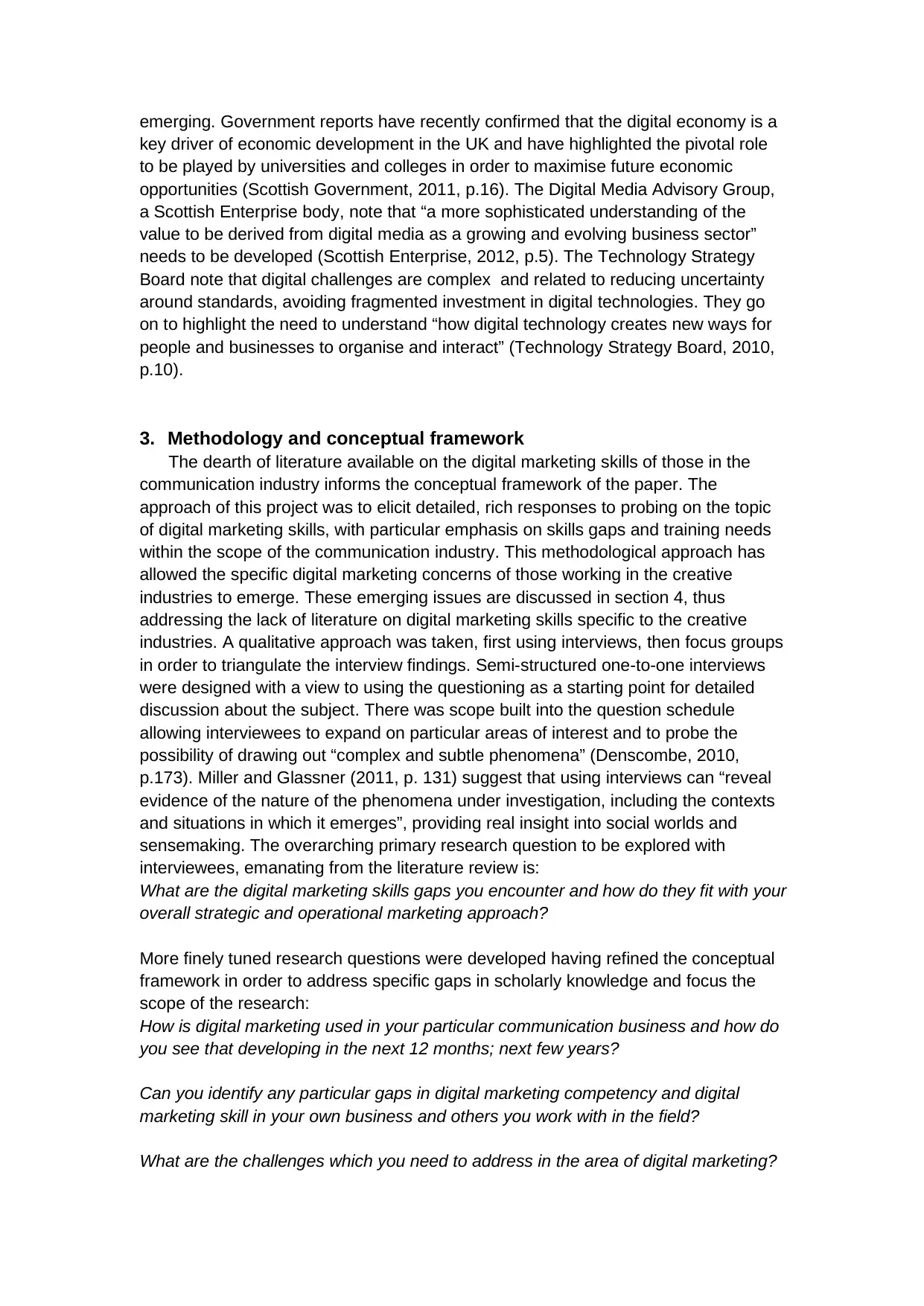
emerging. Government reports have recently confirmed that the digital economy is a
key driver of economic development in the UK and have highlighted the pivotal role
to be played by universities and colleges in order to maximise future economic
opportunities (Scottish Government, 2011, p.16). The Digital Media Advisory Group,
a Scottish Enterprise body, note that “a more sophisticated understanding of the
value to be derived from digital media as a growing and evolving business sector”
needs to be developed (Scottish Enterprise, 2012, p.5). The Technology Strategy
Board note that digital challenges are complex and related to reducing uncertainty
around standards, avoiding fragmented investment in digital technologies. They go
on to highlight the need to understand “how digital technology creates new ways for
people and businesses to organise and interact” (Technology Strategy Board, 2010,
p.10).
3. Methodology and conceptual framework
The dearth of literature available on the digital marketing skills of those in the
communication industry informs the conceptual framework of the paper. The
approach of this project was to elicit detailed, rich responses to probing on the topic
of digital marketing skills, with particular emphasis on skills gaps and training needs
within the scope of the communication industry. This methodological approach has
allowed the specific digital marketing concerns of those working in the creative
industries to emerge. These emerging issues are discussed in section 4, thus
addressing the lack of literature on digital marketing skills specific to the creative
industries. A qualitative approach was taken, first using interviews, then focus groups
in order to triangulate the interview findings. Semi-structured one-to-one interviews
were designed with a view to using the questioning as a starting point for detailed
discussion about the subject. There was scope built into the question schedule
allowing interviewees to expand on particular areas of interest and to probe the
possibility of drawing out “complex and subtle phenomena” (Denscombe, 2010,
p.173). Miller and Glassner (2011, p. 131) suggest that using interviews can “reveal
evidence of the nature of the phenomena under investigation, including the contexts
and situations in which it emerges”, providing real insight into social worlds and
sensemaking. The overarching primary research question to be explored with
interviewees, emanating from the literature review is:
What are the digital marketing skills gaps you encounter and how do they fit with your
overall strategic and operational marketing approach?
More finely tuned research questions were developed having refined the conceptual
framework in order to address specific gaps in scholarly knowledge and focus the
scope of the research:
How is digital marketing used in your particular communication business and how do
you see that developing in the next 12 months; next few years?
Can you identify any particular gaps in digital marketing competency and digital
marketing skill in your own business and others you work with in the field?
What are the challenges which you need to address in the area of digital marketing?
key driver of economic development in the UK and have highlighted the pivotal role
to be played by universities and colleges in order to maximise future economic
opportunities (Scottish Government, 2011, p.16). The Digital Media Advisory Group,
a Scottish Enterprise body, note that “a more sophisticated understanding of the
value to be derived from digital media as a growing and evolving business sector”
needs to be developed (Scottish Enterprise, 2012, p.5). The Technology Strategy
Board note that digital challenges are complex and related to reducing uncertainty
around standards, avoiding fragmented investment in digital technologies. They go
on to highlight the need to understand “how digital technology creates new ways for
people and businesses to organise and interact” (Technology Strategy Board, 2010,
p.10).
3. Methodology and conceptual framework
The dearth of literature available on the digital marketing skills of those in the
communication industry informs the conceptual framework of the paper. The
approach of this project was to elicit detailed, rich responses to probing on the topic
of digital marketing skills, with particular emphasis on skills gaps and training needs
within the scope of the communication industry. This methodological approach has
allowed the specific digital marketing concerns of those working in the creative
industries to emerge. These emerging issues are discussed in section 4, thus
addressing the lack of literature on digital marketing skills specific to the creative
industries. A qualitative approach was taken, first using interviews, then focus groups
in order to triangulate the interview findings. Semi-structured one-to-one interviews
were designed with a view to using the questioning as a starting point for detailed
discussion about the subject. There was scope built into the question schedule
allowing interviewees to expand on particular areas of interest and to probe the
possibility of drawing out “complex and subtle phenomena” (Denscombe, 2010,
p.173). Miller and Glassner (2011, p. 131) suggest that using interviews can “reveal
evidence of the nature of the phenomena under investigation, including the contexts
and situations in which it emerges”, providing real insight into social worlds and
sensemaking. The overarching primary research question to be explored with
interviewees, emanating from the literature review is:
What are the digital marketing skills gaps you encounter and how do they fit with your
overall strategic and operational marketing approach?
More finely tuned research questions were developed having refined the conceptual
framework in order to address specific gaps in scholarly knowledge and focus the
scope of the research:
How is digital marketing used in your particular communication business and how do
you see that developing in the next 12 months; next few years?
Can you identify any particular gaps in digital marketing competency and digital
marketing skill in your own business and others you work with in the field?
What are the challenges which you need to address in the area of digital marketing?
Paraphrase This Document
Need a fresh take? Get an instant paraphrase of this document with our AI Paraphraser
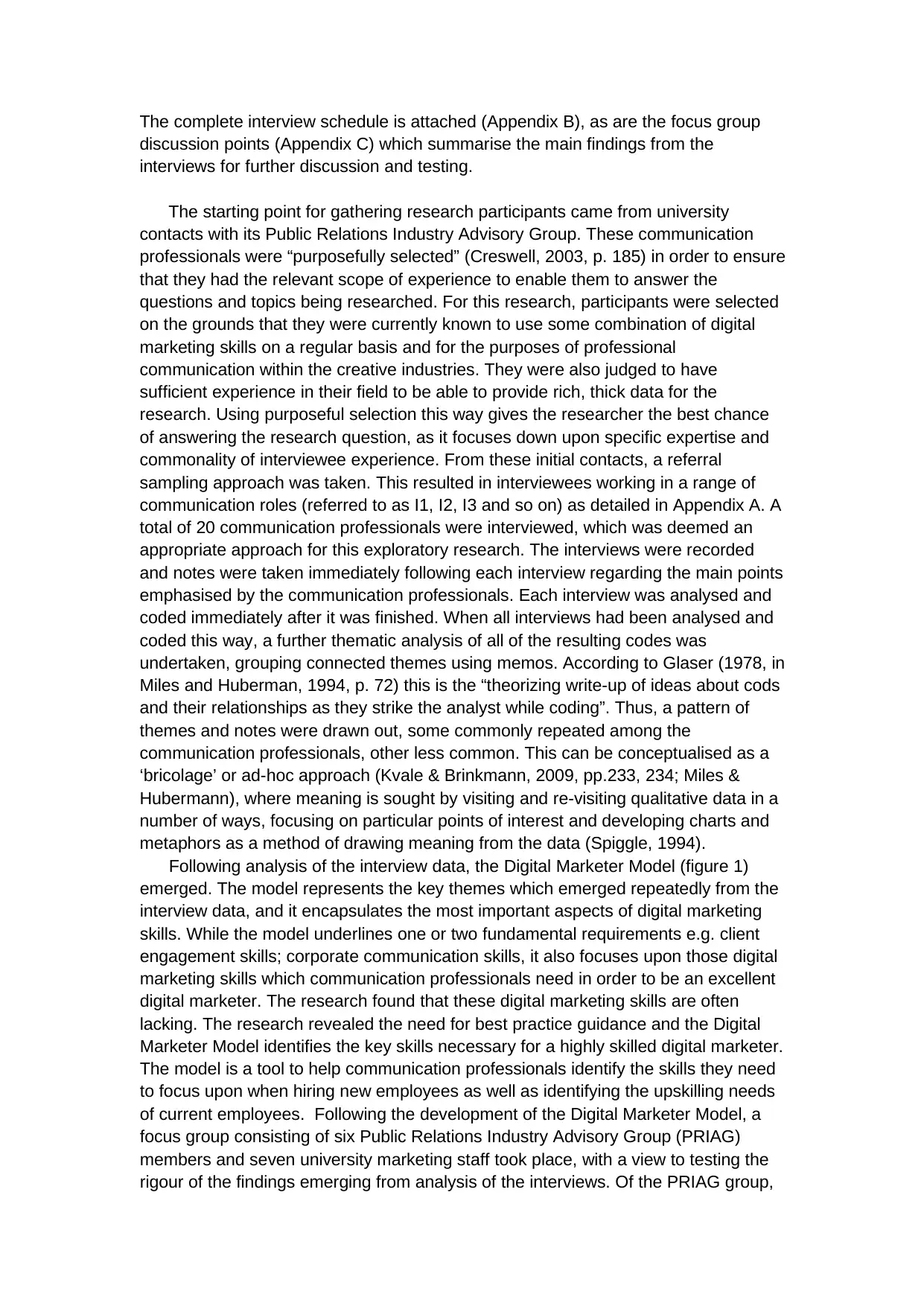
The complete interview schedule is attached (Appendix B), as are the focus group
discussion points (Appendix C) which summarise the main findings from the
interviews for further discussion and testing.
The starting point for gathering research participants came from university
contacts with its Public Relations Industry Advisory Group. These communication
professionals were “purposefully selected” (Creswell, 2003, p. 185) in order to ensure
that they had the relevant scope of experience to enable them to answer the
questions and topics being researched. For this research, participants were selected
on the grounds that they were currently known to use some combination of digital
marketing skills on a regular basis and for the purposes of professional
communication within the creative industries. They were also judged to have
sufficient experience in their field to be able to provide rich, thick data for the
research. Using purposeful selection this way gives the researcher the best chance
of answering the research question, as it focuses down upon specific expertise and
commonality of interviewee experience. From these initial contacts, a referral
sampling approach was taken. This resulted in interviewees working in a range of
communication roles (referred to as I1, I2, I3 and so on) as detailed in Appendix A. A
total of 20 communication professionals were interviewed, which was deemed an
appropriate approach for this exploratory research. The interviews were recorded
and notes were taken immediately following each interview regarding the main points
emphasised by the communication professionals. Each interview was analysed and
coded immediately after it was finished. When all interviews had been analysed and
coded this way, a further thematic analysis of all of the resulting codes was
undertaken, grouping connected themes using memos. According to Glaser (1978, in
Miles and Huberman, 1994, p. 72) this is the “theorizing write-up of ideas about cods
and their relationships as they strike the analyst while coding”. Thus, a pattern of
themes and notes were drawn out, some commonly repeated among the
communication professionals, other less common. This can be conceptualised as a
‘bricolage’ or ad-hoc approach (Kvale & Brinkmann, 2009, pp.233, 234; Miles &
Hubermann), where meaning is sought by visiting and re-visiting qualitative data in a
number of ways, focusing on particular points of interest and developing charts and
metaphors as a method of drawing meaning from the data (Spiggle, 1994).
Following analysis of the interview data, the Digital Marketer Model (figure 1)
emerged. The model represents the key themes which emerged repeatedly from the
interview data, and it encapsulates the most important aspects of digital marketing
skills. While the model underlines one or two fundamental requirements e.g. client
engagement skills; corporate communication skills, it also focuses upon those digital
marketing skills which communication professionals need in order to be an excellent
digital marketer. The research found that these digital marketing skills are often
lacking. The research revealed the need for best practice guidance and the Digital
Marketer Model identifies the key skills necessary for a highly skilled digital marketer.
The model is a tool to help communication professionals identify the skills they need
to focus upon when hiring new employees as well as identifying the upskilling needs
of current employees. Following the development of the Digital Marketer Model, a
focus group consisting of six Public Relations Industry Advisory Group (PRIAG)
members and seven university marketing staff took place, with a view to testing the
rigour of the findings emerging from analysis of the interviews. Of the PRIAG group,
discussion points (Appendix C) which summarise the main findings from the
interviews for further discussion and testing.
The starting point for gathering research participants came from university
contacts with its Public Relations Industry Advisory Group. These communication
professionals were “purposefully selected” (Creswell, 2003, p. 185) in order to ensure
that they had the relevant scope of experience to enable them to answer the
questions and topics being researched. For this research, participants were selected
on the grounds that they were currently known to use some combination of digital
marketing skills on a regular basis and for the purposes of professional
communication within the creative industries. They were also judged to have
sufficient experience in their field to be able to provide rich, thick data for the
research. Using purposeful selection this way gives the researcher the best chance
of answering the research question, as it focuses down upon specific expertise and
commonality of interviewee experience. From these initial contacts, a referral
sampling approach was taken. This resulted in interviewees working in a range of
communication roles (referred to as I1, I2, I3 and so on) as detailed in Appendix A. A
total of 20 communication professionals were interviewed, which was deemed an
appropriate approach for this exploratory research. The interviews were recorded
and notes were taken immediately following each interview regarding the main points
emphasised by the communication professionals. Each interview was analysed and
coded immediately after it was finished. When all interviews had been analysed and
coded this way, a further thematic analysis of all of the resulting codes was
undertaken, grouping connected themes using memos. According to Glaser (1978, in
Miles and Huberman, 1994, p. 72) this is the “theorizing write-up of ideas about cods
and their relationships as they strike the analyst while coding”. Thus, a pattern of
themes and notes were drawn out, some commonly repeated among the
communication professionals, other less common. This can be conceptualised as a
‘bricolage’ or ad-hoc approach (Kvale & Brinkmann, 2009, pp.233, 234; Miles &
Hubermann), where meaning is sought by visiting and re-visiting qualitative data in a
number of ways, focusing on particular points of interest and developing charts and
metaphors as a method of drawing meaning from the data (Spiggle, 1994).
Following analysis of the interview data, the Digital Marketer Model (figure 1)
emerged. The model represents the key themes which emerged repeatedly from the
interview data, and it encapsulates the most important aspects of digital marketing
skills. While the model underlines one or two fundamental requirements e.g. client
engagement skills; corporate communication skills, it also focuses upon those digital
marketing skills which communication professionals need in order to be an excellent
digital marketer. The research found that these digital marketing skills are often
lacking. The research revealed the need for best practice guidance and the Digital
Marketer Model identifies the key skills necessary for a highly skilled digital marketer.
The model is a tool to help communication professionals identify the skills they need
to focus upon when hiring new employees as well as identifying the upskilling needs
of current employees. Following the development of the Digital Marketer Model, a
focus group consisting of six Public Relations Industry Advisory Group (PRIAG)
members and seven university marketing staff took place, with a view to testing the
rigour of the findings emerging from analysis of the interviews. Of the PRIAG group,
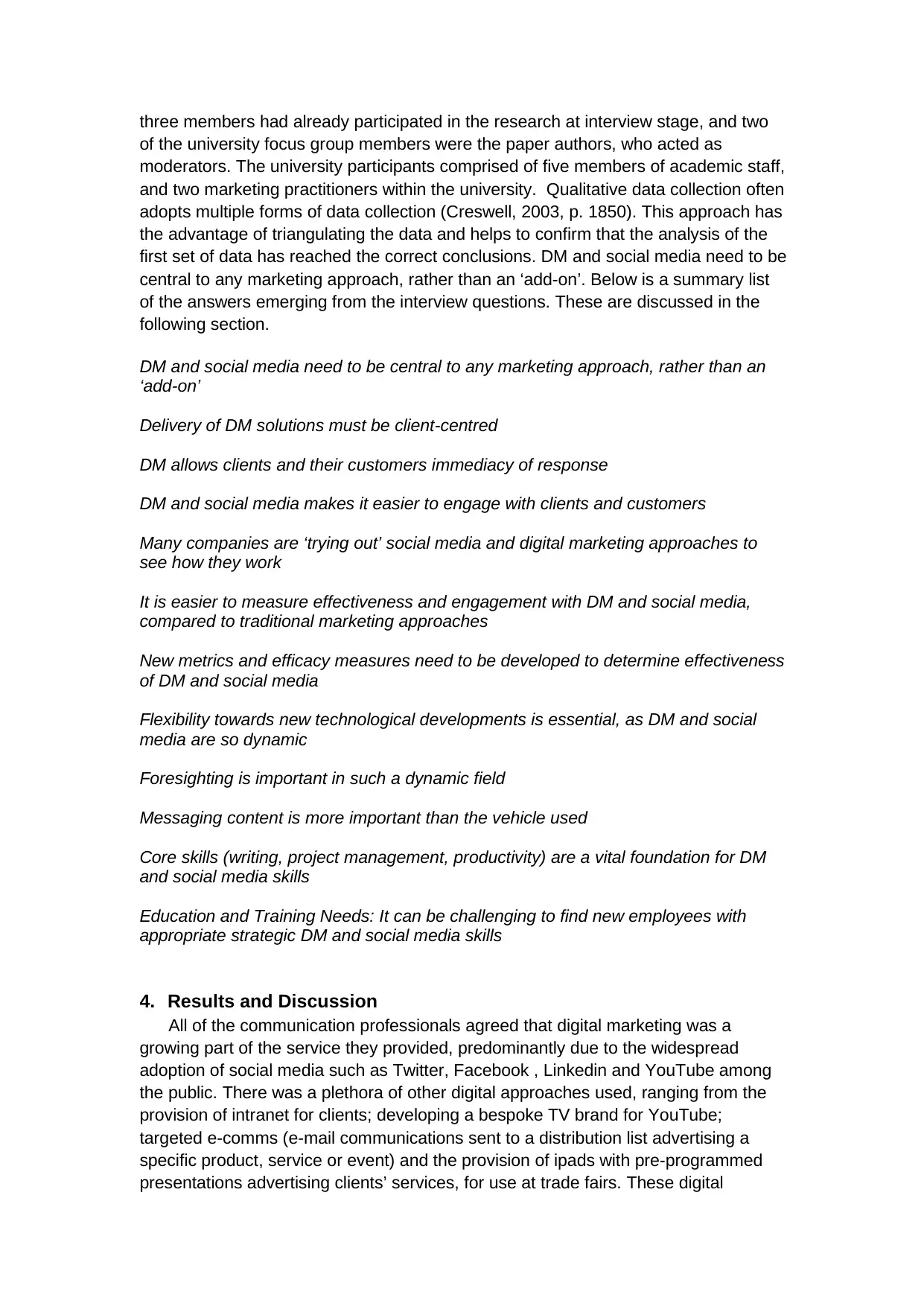
three members had already participated in the research at interview stage, and two
of the university focus group members were the paper authors, who acted as
moderators. The university participants comprised of five members of academic staff,
and two marketing practitioners within the university. Qualitative data collection often
adopts multiple forms of data collection (Creswell, 2003, p. 1850). This approach has
the advantage of triangulating the data and helps to confirm that the analysis of the
first set of data has reached the correct conclusions. DM and social media need to be
central to any marketing approach, rather than an ‘add-on’. Below is a summary list
of the answers emerging from the interview questions. These are discussed in the
following section.
DM and social media need to be central to any marketing approach, rather than an
‘add-on’
Delivery of DM solutions must be client-centred
DM allows clients and their customers immediacy of response
DM and social media makes it easier to engage with clients and customers
Many companies are ‘trying out’ social media and digital marketing approaches to
see how they work
It is easier to measure effectiveness and engagement with DM and social media,
compared to traditional marketing approaches
New metrics and efficacy measures need to be developed to determine effectiveness
of DM and social media
Flexibility towards new technological developments is essential, as DM and social
media are so dynamic
Foresighting is important in such a dynamic field
Messaging content is more important than the vehicle used
Core skills (writing, project management, productivity) are a vital foundation for DM
and social media skills
Education and Training Needs: It can be challenging to find new employees with
appropriate strategic DM and social media skills
4. Results and Discussion
All of the communication professionals agreed that digital marketing was a
growing part of the service they provided, predominantly due to the widespread
adoption of social media such as Twitter, Facebook , Linkedin and YouTube among
the public. There was a plethora of other digital approaches used, ranging from the
provision of intranet for clients; developing a bespoke TV brand for YouTube;
targeted e-comms (e-mail communications sent to a distribution list advertising a
specific product, service or event) and the provision of ipads with pre-programmed
presentations advertising clients’ services, for use at trade fairs. These digital
of the university focus group members were the paper authors, who acted as
moderators. The university participants comprised of five members of academic staff,
and two marketing practitioners within the university. Qualitative data collection often
adopts multiple forms of data collection (Creswell, 2003, p. 1850). This approach has
the advantage of triangulating the data and helps to confirm that the analysis of the
first set of data has reached the correct conclusions. DM and social media need to be
central to any marketing approach, rather than an ‘add-on’. Below is a summary list
of the answers emerging from the interview questions. These are discussed in the
following section.
DM and social media need to be central to any marketing approach, rather than an
‘add-on’
Delivery of DM solutions must be client-centred
DM allows clients and their customers immediacy of response
DM and social media makes it easier to engage with clients and customers
Many companies are ‘trying out’ social media and digital marketing approaches to
see how they work
It is easier to measure effectiveness and engagement with DM and social media,
compared to traditional marketing approaches
New metrics and efficacy measures need to be developed to determine effectiveness
of DM and social media
Flexibility towards new technological developments is essential, as DM and social
media are so dynamic
Foresighting is important in such a dynamic field
Messaging content is more important than the vehicle used
Core skills (writing, project management, productivity) are a vital foundation for DM
and social media skills
Education and Training Needs: It can be challenging to find new employees with
appropriate strategic DM and social media skills
4. Results and Discussion
All of the communication professionals agreed that digital marketing was a
growing part of the service they provided, predominantly due to the widespread
adoption of social media such as Twitter, Facebook , Linkedin and YouTube among
the public. There was a plethora of other digital approaches used, ranging from the
provision of intranet for clients; developing a bespoke TV brand for YouTube;
targeted e-comms (e-mail communications sent to a distribution list advertising a
specific product, service or event) and the provision of ipads with pre-programmed
presentations advertising clients’ services, for use at trade fairs. These digital
⊘ This is a preview!⊘
Do you want full access?
Subscribe today to unlock all pages.

Trusted by 1+ million students worldwide
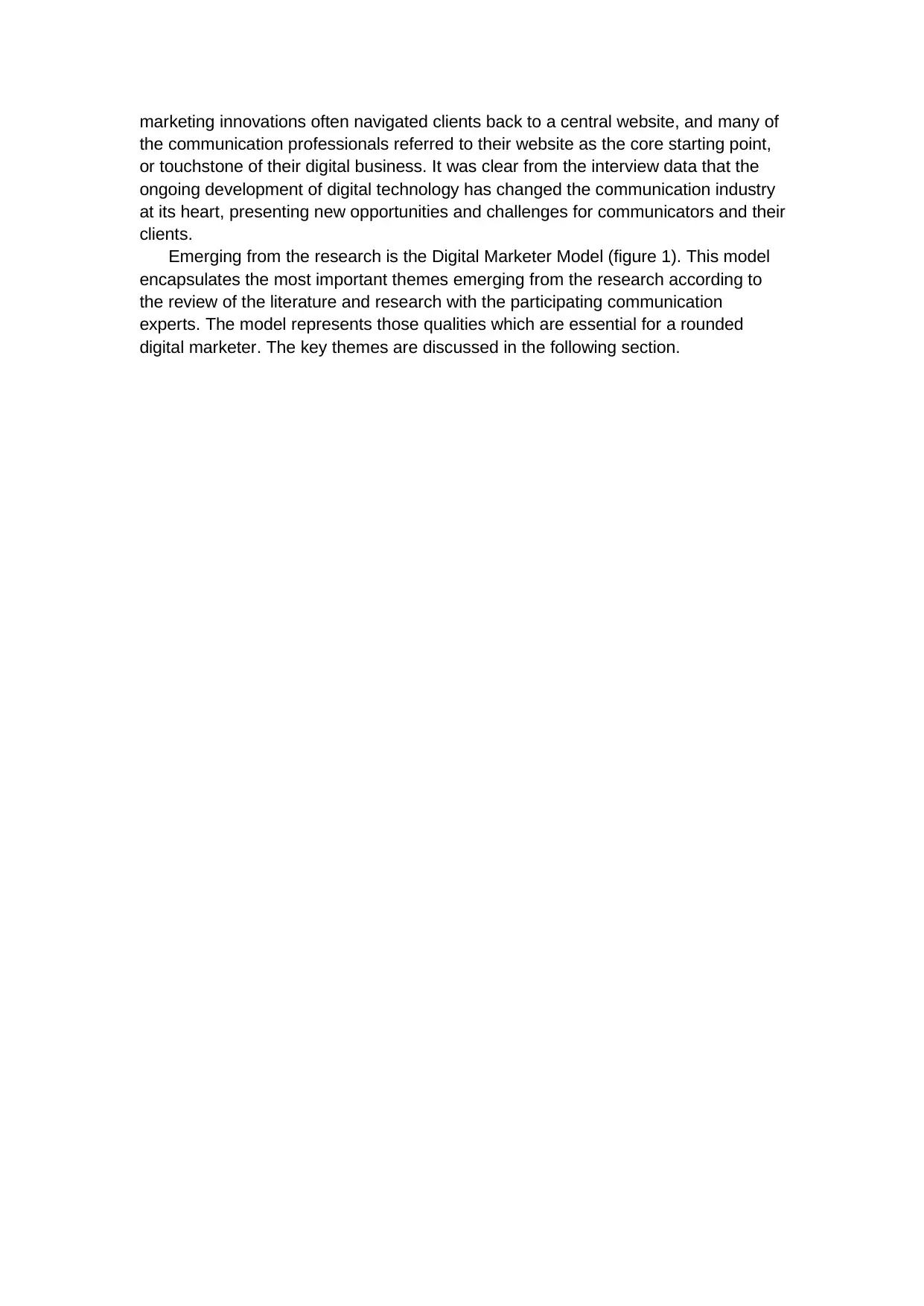
marketing innovations often navigated clients back to a central website, and many of
the communication professionals referred to their website as the core starting point,
or touchstone of their digital business. It was clear from the interview data that the
ongoing development of digital technology has changed the communication industry
at its heart, presenting new opportunities and challenges for communicators and their
clients.
Emerging from the research is the Digital Marketer Model (figure 1). This model
encapsulates the most important themes emerging from the research according to
the review of the literature and research with the participating communication
experts. The model represents those qualities which are essential for a rounded
digital marketer. The key themes are discussed in the following section.
the communication professionals referred to their website as the core starting point,
or touchstone of their digital business. It was clear from the interview data that the
ongoing development of digital technology has changed the communication industry
at its heart, presenting new opportunities and challenges for communicators and their
clients.
Emerging from the research is the Digital Marketer Model (figure 1). This model
encapsulates the most important themes emerging from the research according to
the review of the literature and research with the participating communication
experts. The model represents those qualities which are essential for a rounded
digital marketer. The key themes are discussed in the following section.
Paraphrase This Document
Need a fresh take? Get an instant paraphrase of this document with our AI Paraphraser
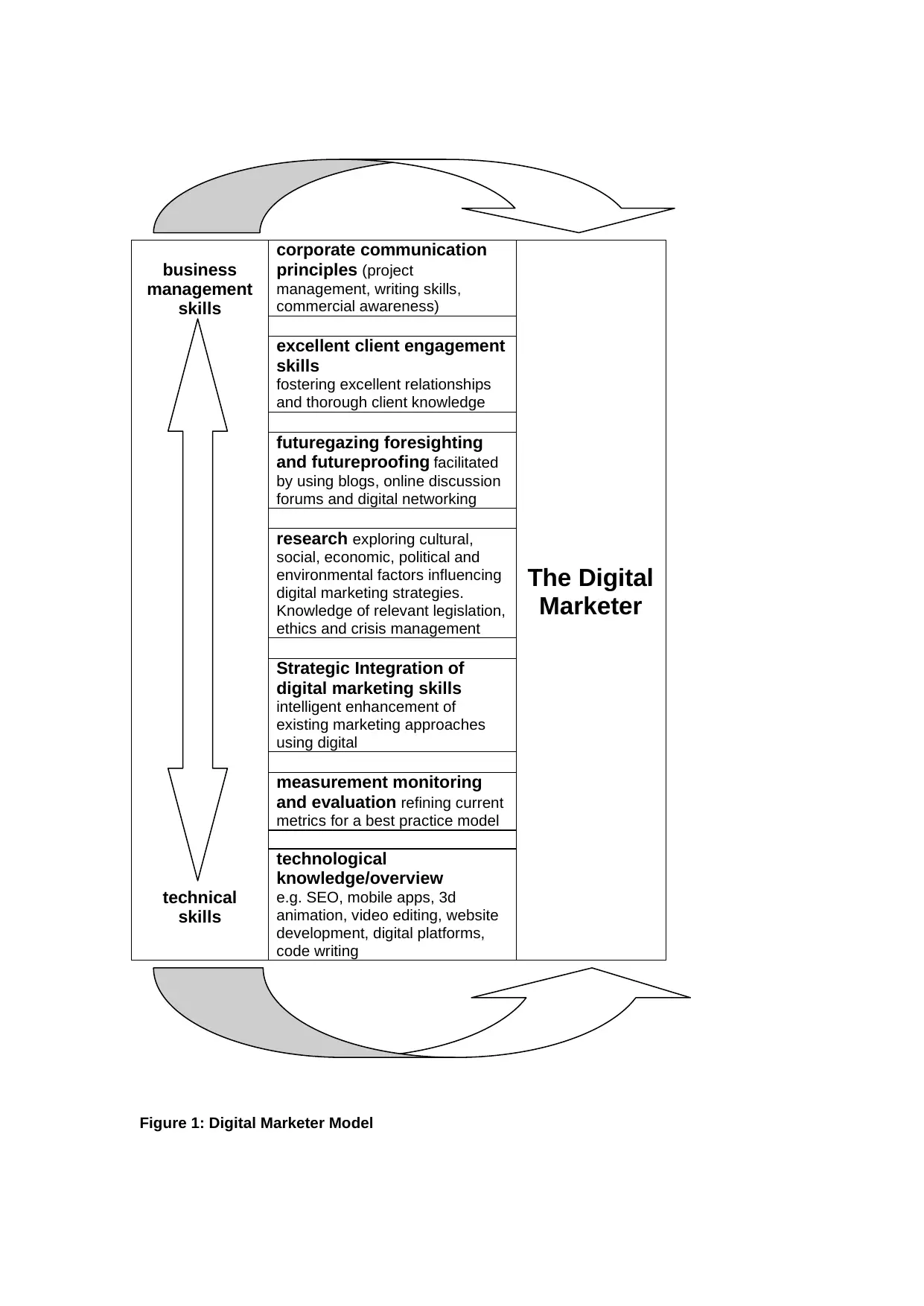
business
management
skills
technical
skills
corporate communication
principles (project
management, writing skills,
commercial awareness)
The Digital
Marketer
excellent client engagement
skills
fostering excellent relationships
and thorough client knowledge
futuregazing foresighting
and futureproofing facilitated
by using blogs, online discussion
forums and digital networking
research exploring cultural,
social, economic, political and
environmental factors influencing
digital marketing strategies.
Knowledge of relevant legislation,
ethics and crisis management
Strategic Integration of
digital marketing skills
intelligent enhancement of
existing marketing approaches
using digital
measurement monitoring
and evaluation refining current
metrics for a best practice model
technological
knowledge/overview
e.g. SEO, mobile apps, 3d
animation, video editing, website
development, digital platforms,
code writing
Figure 1: Digital Marketer Model
management
skills
technical
skills
corporate communication
principles (project
management, writing skills,
commercial awareness)
The Digital
Marketer
excellent client engagement
skills
fostering excellent relationships
and thorough client knowledge
futuregazing foresighting
and futureproofing facilitated
by using blogs, online discussion
forums and digital networking
research exploring cultural,
social, economic, political and
environmental factors influencing
digital marketing strategies.
Knowledge of relevant legislation,
ethics and crisis management
Strategic Integration of
digital marketing skills
intelligent enhancement of
existing marketing approaches
using digital
measurement monitoring
and evaluation refining current
metrics for a best practice model
technological
knowledge/overview
e.g. SEO, mobile apps, 3d
animation, video editing, website
development, digital platforms,
code writing
Figure 1: Digital Marketer Model
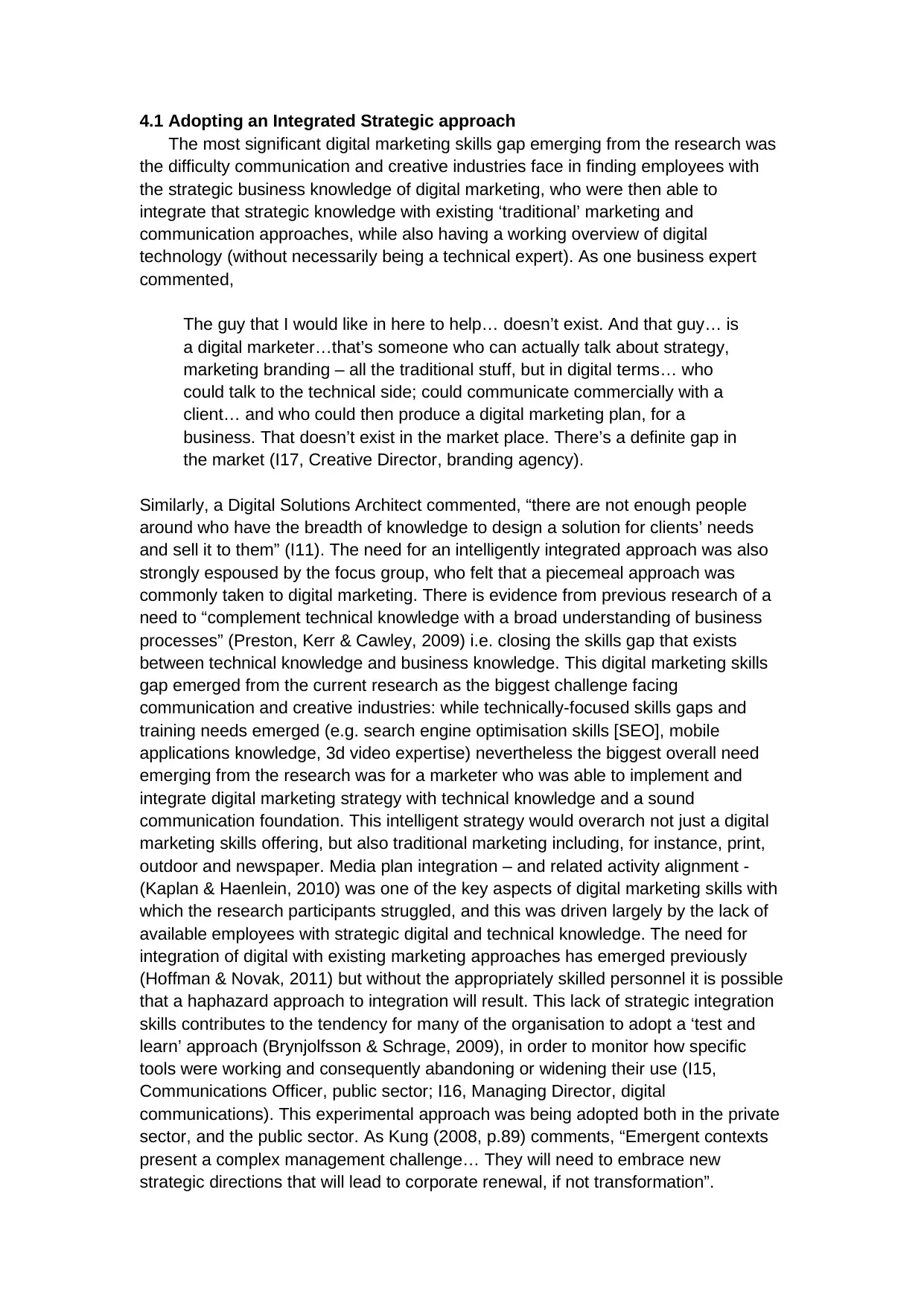
4.1 Adopting an Integrated Strategic approach
The most significant digital marketing skills gap emerging from the research was
the difficulty communication and creative industries face in finding employees with
the strategic business knowledge of digital marketing, who were then able to
integrate that strategic knowledge with existing ‘traditional’ marketing and
communication approaches, while also having a working overview of digital
technology (without necessarily being a technical expert). As one business expert
commented,
The guy that I would like in here to help… doesn’t exist. And that guy… is
a digital marketer…that’s someone who can actually talk about strategy,
marketing branding – all the traditional stuff, but in digital terms… who
could talk to the technical side; could communicate commercially with a
client… and who could then produce a digital marketing plan, for a
business. That doesn’t exist in the market place. There’s a definite gap in
the market (I17, Creative Director, branding agency).
Similarly, a Digital Solutions Architect commented, “there are not enough people
around who have the breadth of knowledge to design a solution for clients’ needs
and sell it to them” (I11). The need for an intelligently integrated approach was also
strongly espoused by the focus group, who felt that a piecemeal approach was
commonly taken to digital marketing. There is evidence from previous research of a
need to “complement technical knowledge with a broad understanding of business
processes” (Preston, Kerr & Cawley, 2009) i.e. closing the skills gap that exists
between technical knowledge and business knowledge. This digital marketing skills
gap emerged from the current research as the biggest challenge facing
communication and creative industries: while technically-focused skills gaps and
training needs emerged (e.g. search engine optimisation skills [SEO], mobile
applications knowledge, 3d video expertise) nevertheless the biggest overall need
emerging from the research was for a marketer who was able to implement and
integrate digital marketing strategy with technical knowledge and a sound
communication foundation. This intelligent strategy would overarch not just a digital
marketing skills offering, but also traditional marketing including, for instance, print,
outdoor and newspaper. Media plan integration – and related activity alignment -
(Kaplan & Haenlein, 2010) was one of the key aspects of digital marketing skills with
which the research participants struggled, and this was driven largely by the lack of
available employees with strategic digital and technical knowledge. The need for
integration of digital with existing marketing approaches has emerged previously
(Hoffman & Novak, 2011) but without the appropriately skilled personnel it is possible
that a haphazard approach to integration will result. This lack of strategic integration
skills contributes to the tendency for many of the organisation to adopt a ‘test and
learn’ approach (Brynjolfsson & Schrage, 2009), in order to monitor how specific
tools were working and consequently abandoning or widening their use (I15,
Communications Officer, public sector; I16, Managing Director, digital
communications). This experimental approach was being adopted both in the private
sector, and the public sector. As Kung (2008, p.89) comments, “Emergent contexts
present a complex management challenge… They will need to embrace new
strategic directions that will lead to corporate renewal, if not transformation”.
The most significant digital marketing skills gap emerging from the research was
the difficulty communication and creative industries face in finding employees with
the strategic business knowledge of digital marketing, who were then able to
integrate that strategic knowledge with existing ‘traditional’ marketing and
communication approaches, while also having a working overview of digital
technology (without necessarily being a technical expert). As one business expert
commented,
The guy that I would like in here to help… doesn’t exist. And that guy… is
a digital marketer…that’s someone who can actually talk about strategy,
marketing branding – all the traditional stuff, but in digital terms… who
could talk to the technical side; could communicate commercially with a
client… and who could then produce a digital marketing plan, for a
business. That doesn’t exist in the market place. There’s a definite gap in
the market (I17, Creative Director, branding agency).
Similarly, a Digital Solutions Architect commented, “there are not enough people
around who have the breadth of knowledge to design a solution for clients’ needs
and sell it to them” (I11). The need for an intelligently integrated approach was also
strongly espoused by the focus group, who felt that a piecemeal approach was
commonly taken to digital marketing. There is evidence from previous research of a
need to “complement technical knowledge with a broad understanding of business
processes” (Preston, Kerr & Cawley, 2009) i.e. closing the skills gap that exists
between technical knowledge and business knowledge. This digital marketing skills
gap emerged from the current research as the biggest challenge facing
communication and creative industries: while technically-focused skills gaps and
training needs emerged (e.g. search engine optimisation skills [SEO], mobile
applications knowledge, 3d video expertise) nevertheless the biggest overall need
emerging from the research was for a marketer who was able to implement and
integrate digital marketing strategy with technical knowledge and a sound
communication foundation. This intelligent strategy would overarch not just a digital
marketing skills offering, but also traditional marketing including, for instance, print,
outdoor and newspaper. Media plan integration – and related activity alignment -
(Kaplan & Haenlein, 2010) was one of the key aspects of digital marketing skills with
which the research participants struggled, and this was driven largely by the lack of
available employees with strategic digital and technical knowledge. The need for
integration of digital with existing marketing approaches has emerged previously
(Hoffman & Novak, 2011) but without the appropriately skilled personnel it is possible
that a haphazard approach to integration will result. This lack of strategic integration
skills contributes to the tendency for many of the organisation to adopt a ‘test and
learn’ approach (Brynjolfsson & Schrage, 2009), in order to monitor how specific
tools were working and consequently abandoning or widening their use (I15,
Communications Officer, public sector; I16, Managing Director, digital
communications). This experimental approach was being adopted both in the private
sector, and the public sector. As Kung (2008, p.89) comments, “Emergent contexts
present a complex management challenge… They will need to embrace new
strategic directions that will lead to corporate renewal, if not transformation”.
⊘ This is a preview!⊘
Do you want full access?
Subscribe today to unlock all pages.

Trusted by 1+ million students worldwide
1 out of 24
Your All-in-One AI-Powered Toolkit for Academic Success.
+13062052269
info@desklib.com
Available 24*7 on WhatsApp / Email
![[object Object]](/_next/static/media/star-bottom.7253800d.svg)
Unlock your academic potential
Copyright © 2020–2025 A2Z Services. All Rights Reserved. Developed and managed by ZUCOL.

